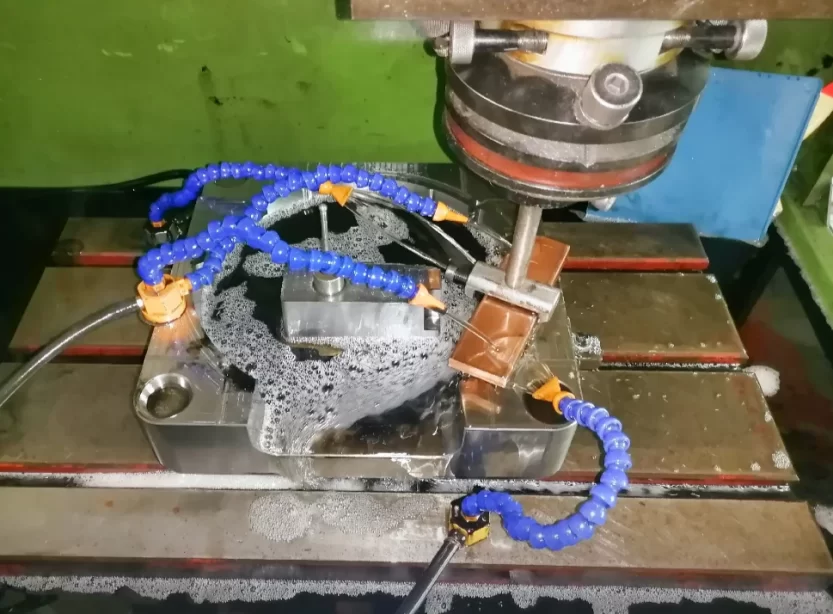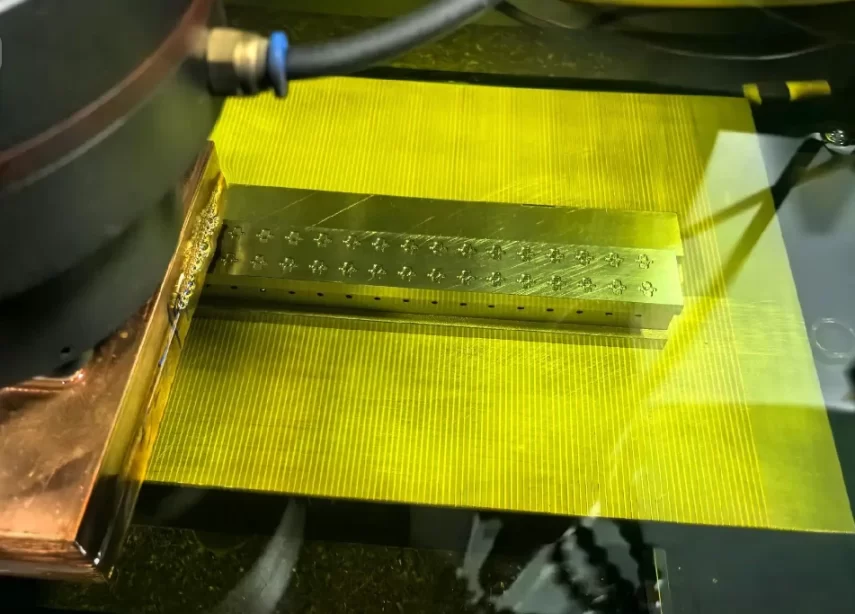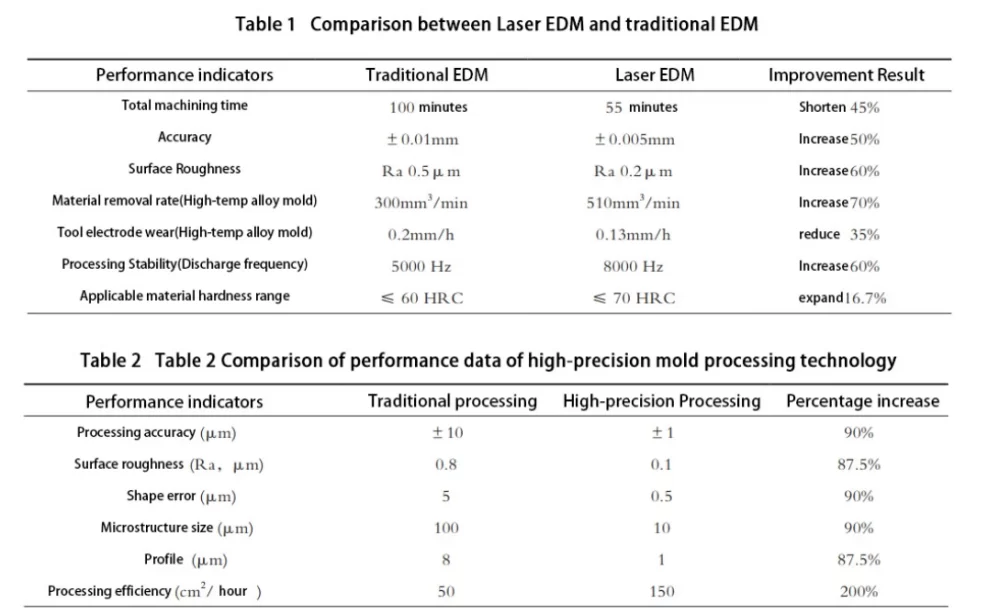Application of high-precision mold processing technology in machinery manufacturing
In today’s rapidly developing manufacturing industry, high-precision mold processing technology has become critical in improving product quality, shortening the product manufacturing cycle, and enhancing market competitiveness.
With consumers’ increasing requirements for the precision and appearance of mold products, traditional processing methods have been unable to meet the needs of the modern manufacturing industry. The emergence and development of high-precision mold processing technology provide an effective way to solve this problem.
This paper discusses the application of high-precision mold processing technology in machinery manufacturing, analyzes its key technologies and their impact on the manufacturing process, and analyzes experimental data to verify its significant effect on improving machining accuracy, improving product surface quality, and extending the mold’s service life.

Breakthrough and innovation of precision milling technology
Precision iron-cutting technology plays a core role in commercial precision mold processing. In recent years, the introduction of high-speed five-axis linkage machining centers significantly improved complex surface processing efficiency and precision!
In the actual application, using five-axis linkage technology to process a set of automotive lamp molds shortened the processing time by 40%, and the surface roughness was improved to Ra0.2um. The selection and optimization of super-hard cutting tool materials is another breakthrough point.
Experiments show that using nano-coated cubic boron nitride tool machining of high-hardness mold steel extends tool life by twofold and increases machining accuracy by 25%.
In addition, the intelligent regulation of cutting parameters has also made significant progress. By monitoring the cutting force and temperature in real-time and automatically adjusting the feed rate and spindle speed, machining accuracy is ensured and the tool wear rate is reduced by 30%.
These innovations have greatly improved the application of precision milling in mold manufacturing, enabling the rapid production of high-quality molds and laying the foundation.
EDM refinement and intelligence
1. Microelectrode design and Manufacturing
The design and manufacture of microelectrodes are the core of EDM refinement. To manufacture micro-fine electrodes, a multi-step precision machining method is used.
First of all, high-precision five-axis CNC machine tools are used on the electrode material (such as copper tungsten alloy) for rough machining, forming the basic contour.
Subsequently, the electrode surface roughness was controlled below Ra0.05um by using microfabrication technology for finishing.
A 2-3um thick nanoscale titanium alloy coating was plated on the electrode surface to improve wear resistance and electrical conductivity. In terms of geometric design, CAD software combined with FEA optimized the electrode shape.
For example, a “stepped” electrode, with each step 0.2mm wide and 0.5mm high, is used for deep machining to improve coolant flow efficiency and reduce wear.
Micro-hole machining uses hollow electrodes with an inner diameter of 0.05mm and an outer diameter of 0.1mm, taking into account accuracy and waste discharge.
These methods can make the electrode diameter 0.01mm, significantly improving the processing fineness and efficiency.
2. Adaptive control of discharge parameters
Adaptive control of discharge parameters is the core of EDM refinement and intelligence. The system dynamically adjusts the discharge energy, pulse width, frequency, and other parameters by monitoring the processing gap voltage and current in real-time.
In the high-temperature alloy mold processing experiments, adaptive control technology increased processing efficiency by 25%, and the surface roughness was down to Ra 0.8 um.
According to the processing stage, intelligent control algorithms automatically select the best combination of parameters, effectively avoiding short-circuit and arc-breaking phenomena!)
For example, roughing uses high-energy, low-frequency discharging, and finishing shifts to low-energy, high-frequency settings.
This strategy improves machining accuracy and extends electrode life. In the 200-hour continuous machining test, the electrode wear rate was reduced by 30%.
After introducing machine learning algorithms, the system can continuously optimize the parameter selection strategy to further improve the machining effect.
3. EDM strategy for complex surfaces
The EDM strategy for complex surfaces has developed an adaptive trajectory planning algorithm for precision control.
The algorithm dynamically adjusts the electrode feed path and speed according to the surface’s geometric features, effectively reducing overcutting and undercutting.
In the experiments of automobile mold machining, the surface roundness error is reduced by 40% to ±0.005mm after adopting this strategy. Multi-electrode collaborative machining technology improves efficiency, and the overall time is shortened by 35% through the reasonable allocation of tasks and the simultaneous use of 3-5 electrodes to machine different areas.
The electrode compensation technology automatically adjusts the feed rate according to the real-time wear measurement to ensure stable machining accuracy over a long period. Fifty hours of continuous surface machining tests showed that the deviation of the final contour accuracy was controlled within ±0.003mm.
The following formula calculates the average gap D between the electrode and the workpiece surface in complex surface machining.
D=K x(a+b+c)
D represents the discharge gap, K is the coefficient, a, b, and c is the cutting electrode’s thickness, the workpiece material’s thickness, and the distance from the electrode to the workpiece.

Application of laser processing technology in mold manufacturing
1. Ultra-short pulse laser micromachining
Ultrashort pulse laser micromachining technology in mold manufacturing shows excellent performance.
The application of a femtosecond laser increases processing accuracy to a submicron level, enabling the creation of micron-level fine structures on the surface of the mold.
Experiments have shown that a laser with a wavelength of 1064nm and a pulse width of 200fs can process mold steel and create microgrooves with a minimum line width of 2wm and a depth-to-width ratio of up to 20:1.
This technology is particularly suitable for manufacturing miniature injection molds, such as cell phone camera lenses.
In a case study of optical molds, the surface roughness of the molds was reduced to Ra 0.05μm by using the ultrashort pulse laser, which is an 80% improvement over the conventional processing method.
In addition, the heat-affected zone is extremely small, effectively avoiding material deformation and micro-cracks and improving the mold’s service life.
The technology can also realize the direct processing of three-dimensional microstructures, providing new possibilities for manufacturing complex functional surfaces.
2. Laser surface treatment and strengthening
Laser surface treatment and strengthening technology significantly improve the mold’s wear resistance and service life.
Laser quenching treatment through rapid heating and cooling, the formation of a hardened layer on the surface of the mold, a thickness of up to 0.5-2mm. Experimental data show that the surface hardness of the mold steel by laser quenching treatment from the original HRC 45 to HRC 62, wear resistance increased by 3 times.
Laser cladding technology can be deposited on the surface of the mold’s high hardness, corrosion-resistant alloy layer.
In die-casting mold strengthening experiments, the use of Ni-based alloy powder laser cladding formed a reinforced layer with a thickness of 0.8mm, extending mold life by 2.5 times.
The laser surface texturing technique significantly improved mold release performance by creating micron-sized regular structures on the mold surface.
Test results show that after laser structuring treatment of injection molds, mold release force was reduced by 40%, and the product surface quality improved by 25%.
3. Laser-Electrical Discharge Composite Machining Process
The laser-EDM composite machining process combines the advantages of the two technologies, significantly improving processing efficiency and precision.
The process first uses the laser to rough out and rapidly remove large amounts of material, and then EDM is used to finish the process to achieve a high-precision surface.
In the mold processing experiment, compared with a single EDM, the composite process reduced the total processing time by 45% while maintaining a high accuracy of ± 0.005mm.
Laser pretreatment can also improve the discharge conditions of EDM and enhance processing stability.
Experimental data show that the surface roughness of the mold processed by the composite process can be up to Ra0.2um, which is 60% higher than the traditional EDM.

Comprehensive benefit analysis of high-precision mold processing technology
1. Improvement of processing accuracy and surface quality
Applying high-precision mold processing technology significantly improves the processing accuracy and surface quality.
Through the integration of ultra-short pulse laser, precision milling, EDM, and other advanced technologies, the mold manufacturing industry has achieved processing accuracy at the micron or even submicron level.
For example, five-axis linkage machining centers combined with super-hard cutting tools can reduce molds’ surface roughness to below Ra 0.2pm.
The composite application of EDM and laser technology has increased the precision of microstructure machining by 30%.
The combined use of these technologies improves the mold’s geometric accuracy and significantly improves its surface quality.
Experimental data show that compared with traditional processing methods, the new technology can control the shape error within ±2μm, surface roughness increased by more than 50%.
This improvement in precision and quality directly affects the performance and appearance of the final product, especially in precision electronics, optical components, and medical devices, providing key support for product innovation and performance breakthroughs.
2. Extension of mold life and cost reduction
High-precision mold processing technology significantly extends mold life and reduces production costs.
Precision machining and surface treatment significantly improve the wear and corrosion resistance of the mold.
Practical data show that the mold’s service life has been extended by an average of 2.5 times due to laser surface enhancement treatment.
This means less frequent mold replacement, which directly reduces production costs.
At the same time, high-precision machining improves the machining accuracy and surface quality of the mold, reducing the rate of product defects and, thus, the scrap rate.
In the case of an automotive parts manufacturing enterprise, the introduction of high-precision machining technology increased mold life from the original 500,000 stampings to 1.2 million times, and mold-related costs were reduced by 40%.
In addition, due to the improvement in processing precision mold, maintenance and repair frequency are also greatly reduced, further reducing downtime and maintenance costs.
Overall, high-precision mold processing technology not only extends the life of the mold but also achieves significant economic benefits by improving productivity and reducing maintenance costs.
3. Shortening of the product development cycle and its economic benefits
High-precision mold processing technology significantly shortens the product development cycle, bringing significant economic benefits.
The traditional mold manufacturing process often requires multiple trials and modifications, which is time-consuming and costly.
High-precision machining technology can achieve higher accuracy in one go, reducing the need for repeated modifications.
Data show that the use of five-axis machining centers and intelligent design systems shortens the mold development cycle by an average of 40%.
This improved efficiency allows companies to bring new products to market faster and seize the opportunity.
In the case of one consumer electronics manufacturer, the time from design to mass production of a new product was reduced from six months to 3.5 months, significantly improving market responsiveness.
The shortened development cycle not only reduced R&D costs but also increased the company’s market competitiveness.
In addition, high-precision machining technology improves the first-time success rate and reduces the number of sample production and testing, further saving time and material costs.
The shortening of the product development cycle brings significant economic benefits to the enterprise, including cost savings, increased market share, and enhanced brand value.
Conclusion
Applying high-precision mold processing technology in machinery manufacturing promotes manufacturing process innovation and significantly improves product quality and production efficiency.
Through the organic combination of precision milling, EDM, and laser processing technologies, it solves processing problems involving the high precision requirements of complex shapes.
Experimental results show that the application of these advanced technologies, which increase mold processing accuracy by more than 30% and reduce surface roughness to the nanometer level at the same time, will extend the life of the mold 2-3 times.
In the future, with the in-depth integration of digital and intelligent technology, high-precision mold processing technology will continue to lead the machinery manufacturing industry to higher quality, more efficient direction of development, product innovation, and industrial upgrading to provide strong technical support.